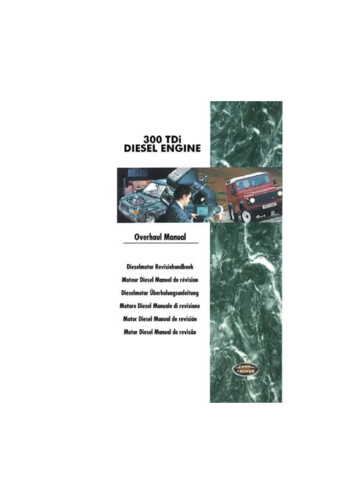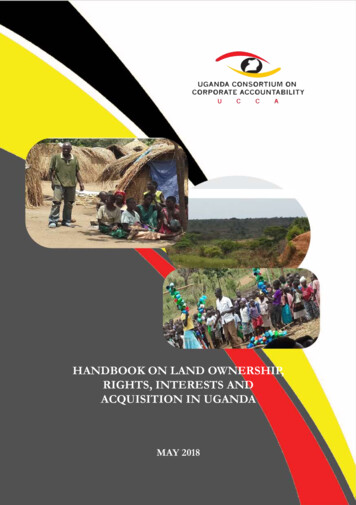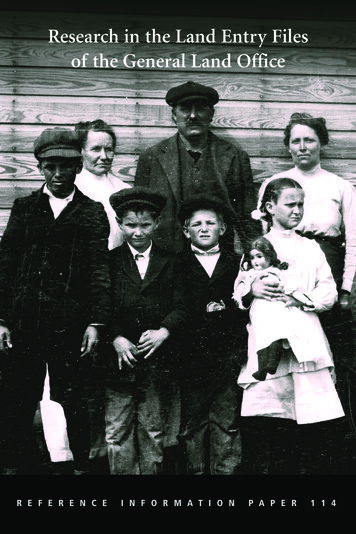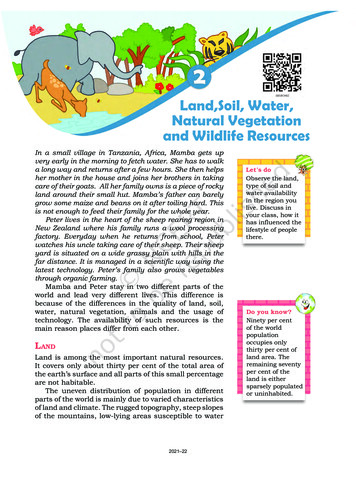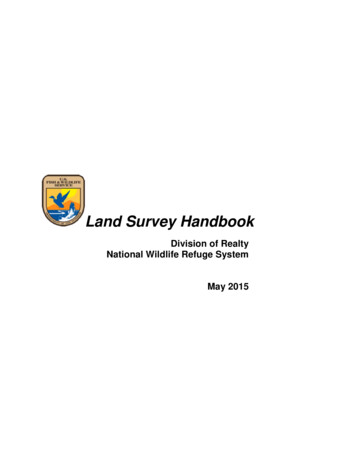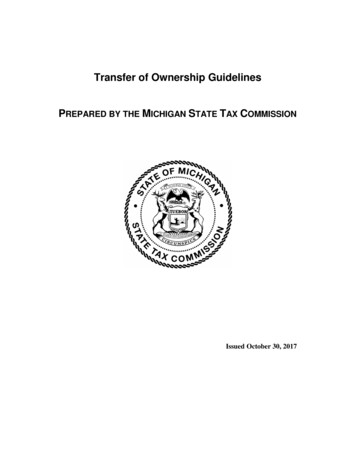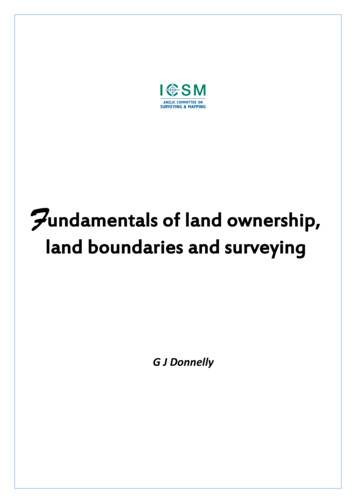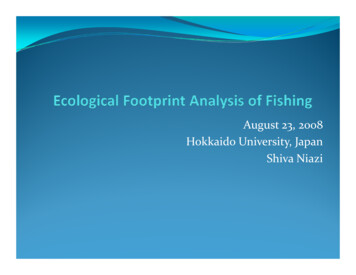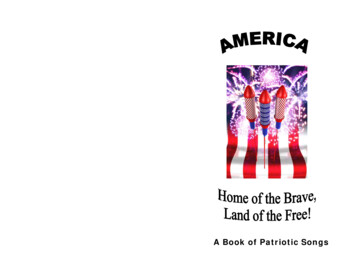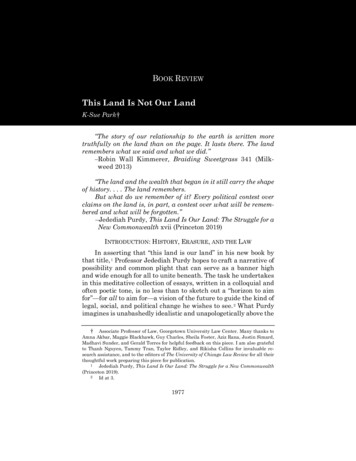
Transcription
BOOK REVIEWThis Land Is Not Our LandK-Sue Park†“The story of our relationship to the earth is written moretruthfully on the land than on the page. It lasts there. The landremembers what we said and what we did.”–Robin Wall Kimmerer, Braiding Sweetgrass 341 (Milkweed 2013)“The land and the wealth that began in it still carry the shapeof history. . . . The land remembers.But what do we remember of it? Every political contest overclaims on the land is, in part, a contest over what will be remembered and what will be forgotten.”–Jedediah Purdy, This Land Is Our Land: The Struggle for aNew Commonwealth xvii (Princeton 2019)INTRODUCTION: HISTORY, ERASURE, AND THE LAWIn asserting that “this land is our land” in his new book bythat title, 1 Professor Jedediah Purdy hopes to craft a narrative ofpossibility and common plight that can serve as a banner highand wide enough for all to unite beneath. The task he undertakesin this meditative collection of essays, written in a colloquial andoften poetic tone, is no less than to sketch out a “horizon to aimfor”—for all to aim for—a vision of the future to guide the kind oflegal, social, and political change he wishes to see. 2 What Purdyimagines is unabashedly idealistic and unapologetically above the† Associate Professor of Law, Georgetown University Law Center. Many thanks toAmna Akbar, Maggie Blackhawk, Guy Charles, Sheila Foster, Aziz Rana, Justin Simard,Madhavi Sunder, and Gerald Torres for helpful feedback on this piece. I am also gratefulto Thanh Nguyen, Tammy Tran, Taylor Ridley, and Rikisha Collins for invaluable research assistance, and to the editors of The University of Chicago Law Review for all theirthoughtful work preparing this piece for publication.1Jedediah Purdy, This Land Is Our Land: The Struggle for a New Commonwealth(Princeton 2019).2Id at 3.1977
1978The University of Chicago Law Review[87:1977world of concrete prescription: he dreams of “an economy thatprizes the work of sustaining and renewing the human world,” 3 asociety in which institutions would support “the flourishing ofeveryone and everything would sustain the flourishing of eachperson.” 4 To reach that horizon, he emphasizes throughout thatwe must overcome our conflicts and divisions and prioritize thatshared vision of the future: we must reach “answers that peoplecan live by together.” 5 For Purdy, the land is a metaphoric resource, a keeper of history, and the literal ground of our commoncondition. In those capacities, it helps him underscore that, forbetter or worse, we are all here, to flourish or perish together.In this book, which he pitches to a popular audience, Purdyturns to the land as a means of reorienting a divided Americanpublic toward more communitarian values and norms. In doingso, he follows in the footsteps of such introspective environmentalists as Henry David Thoreau and Wendell Berry, and, likethem, anchors his hopeful imaginations in a critique, made all themore urgent by the looming threat of climate disaster, of the direinequality and degradation of all forms of life that dominant capitalist modes of production and exchange have wrought. As hebuilds his historical narrative of how we arrived at this point,Purdy also describes the inequalities and racial violence of thepresent as legacies of colonization and slavery; and he explainsthat these largely “forgotten” histories 6 nevertheless have determined the shape of the landscape, the infrastructure, and the dynamics of our interactions in the present. In this way, Purdy explicitly directs his message at everyone who belongs to thisfractured populace, to call them into concerted action. This ambitious project attempts to provide universal answers to some of themost critical yet seemingly insoluble questions of our times: Howcan we cultivate communication across our differences that willmake it possible to work together in the face of existential threatsto our collective survival? How can we learn to understand oneanother when the tremendously violent histories that sowed theterrain of conflict today have been suppressed for so long and inso many ways, such that we lack the information to know whereothers, and perhaps where we, ourselves, are coming from?3456Id at 148.Id at xiii.Purdy, This Land Is Our Land at xxiii (cited in note 1).Id at xvii.
2020]This Land Is Not Our Land1979This Book Review reflects on the importance of the questionsthat Purdy presents, especially for the legal academy, as well asthe shortcomings of his own engagement with them. Purdyrightly calls for a reframing of our collective relationship to theland and each other. Furthermore, he understands that recognizing the histories of conquest and slavery and their erasure is critical to any project that aims to unify a deeply divided public. Foregrounding this problem simultaneously invites and creates spacefor a difficult but necessary set of conversations about our differences, our divergent perspectives, and the ways those historieshave shaped both. This choice is all the more commendable because it is relatively unusual in legal scholarship; underliningsuppressed historical foundations is especially rare when the focus of a work, like this book, is not itself to engage in the task ofrecovering these histories. However, Purdy’s invocation of thesehistories raises more questions than he answers about their connection to the stories, ideas, and experiences he shares in the restof the book. Further, though the book poses questions about thesignificance of these histories and the problem of erasure that areespecially salient for the legal academy, it does not appear conscious of what these histories can tell us about the law and legalinstitutions, nor of the specific dimensions of what doing this kindof work entails.By prioritizing these histories in his work nonetheless,Purdy’s goal appears to be to raise up the concerns of broad anddiverse social movements and to bring them into the fold of hisown communitarian vision. His choice to highlight these questions feels deliberately resonant with broader messages fromglobal political movements of the moment. These movements,chiefly led by youth, have popularized a range of critiques of capitalist markets, their devastation of the environment, and the intertwined histories of colonization and growth of the Atlanticslave trade out of which those markets arose. 7 Over the last decade, and at an intensifying pace, public awareness of these histories has burgeoned, spurred by broadly publicized police and7Purdy also aligns himself with these movements by insisting on hope. One of hismain goals appears to be to convert the despair and abandonment of the future of cynicsand nihilists into a sense of urgency about the present. For example, he diagnoses a “creepingly nihilistic” view that “we are just waiting for the end” and concludes: “We are suffering not from ignorance or innocence but from a lack of faith that understanding can helpus.” See id at 149.
1980The University of Chicago Law Review[87:1977military brutality and worldwide demonstrations following thepolice murders of George Floyd and Breonna Taylor, protestmovements in Ferguson and in Standing Rock, activist organizations like Black Lives Matter and Idle No More, and landmarkcommentaries from Michelle Alexander and Ta-Nehisi Coates. 8Indeed, in “The Case for Reparations,” Coates laid confronting thehistory of slavery and its aftermath down as a gauntlet for thefuture, writing: “We cannot escape our history. All of our solutionsto the great problems of health care, education, housing, and economic inequality are troubled by what must go unspoken.” 9This rising public engagement with the past has fostered thedismantling of more and more Confederate monuments, statues,and plaques; 10 the end of Santa Fe’s Entrada pageant celebratingconquest; 11 the growing replacement of Columbus Day with Indigenous People’s Day 12 and observation of a National Day ofMourning on Thanksgiving; 13 the renaming of residential community names 14 and the revision of university seals, 15 state flags,8See generally Michelle Alexander, The New Jim Crow: Mass Incarceration in theAge of Colorblindness (New Press 2012); Ta-Nehisi Coates, The Case for Reparations (TheAtlantic, June 2014), archived at https://perma.cc/R4JJ-RDPD.9See Coates, The Case for Reparations (cited in note 8).10 See Jasmine Aguilera, Confederate Statues Are Being Removed Amid Protests OverGeorge Floyd’s Death. Here’s What to Know (Time, June 9, 2020) archived athttps://perma.cc/3294-DC7A; Bonnie Berkowitz and Adrian Blanco, Confederate Monuments Are Falling, But Hundreds Still Stand. Here’s Where. (Wash Post, July 2, 2020)archived at https://perma.cc/S2FK-NPSM; Confederate Monuments Are Coming DownAcross the United States. Here’s a List. (NY Times, Aug 28, 2017), archived athttps://perma.cc/YT69-UCST.11 See Daniel J. Chacón, Fiesta Drops Divisive Entrada Pageant in Santa Fe (TheSanta Fe New Mexican, July 24, 2018), archived at https://perma.cc/58P7-Q9YT.12 See AJ Willingham, These States and Cities Are Ditching Columbus Day to Observe Indigenous Peoples’ Day Instead (CNN, Oct 14, 2019), archived athttps://perma.cc/YS7W-7GRQ.13 See Kelly Wynne, What Is National Day of Mourning? How Anti-ThanksgivingDay Started and Everything to Know About It (Newsweek, Nov 27, 2019), archived athttps://perma.cc/3XFV-JGX2.14 See, for example, Andy Newman and Vivian Wang, Calhoun Who? Yale DropsName of Slavery Advocate for Computer Pioneer (NY Times, Sept 3, 2017), archived athttps://perma.cc/96HC-D67V.15 See, for example, Abby Jackson, Harvard Law School Finally Removed the Seal ofa ‘Brutal Slaveholder,’ but Not Everyone Agrees with the Decision (Business Insider, Mar15, 2016), archived at https://perma.cc/ATY6-HD92.
2020]This Land Is Not Our Land1981school mascots, 16 and professional sports teams’ names; 17 Indigenous mapping projects; 18 a congressional hearing on reparations 19and the creation of university reparations funds; 20 new media projects; 21 and increasing recognition of Indigenous and Black struggles across the country and worldwide. 22 The growing public conversation has also increasingly knit itself to and raised the profileof historical scholarship that examines the ways that conquestand slavery shaped, for example, insurance systems, 23 foreclosure, 24 credit markets, 25 investment banking, 26 and accountingpractices. 27 Last year, the launch of the New York Times’s16 See, for example, Christine Hauser, Maine Just Banned Native American Mascots.It’s a Movement That’s Inching Forward (NY Times, May 22, 2019), archived athttps://perma.cc/HA85-ZUN7.17 See, for example, Terence Moore, Washington Redskins Name Change Makes Atlanta Braves, Kansas City Chiefs and Others Look Clueless (Forbes, July 13, 2020), archived at https://perma.cc/9K3S-VTYU.18 See, for example, UCLA American Indian Studies Center, Mapping IndigenousLA: Place-Making Through Digital Storytelling, archived at https://perma.cc/53TH-XG2B;David Grossman, Tribal Map of America Shows Whose Land You’re Actually Living On(Popular Mechanics, Oct 14, 2019), archived at https://perma.cc/LHR7-3BA7; Hansi LoWang, The Map of Native American Tribes You’ve Never Seen Before (NPR, June 24, 2014),archived at https://perma.cc/4Y2L-MNYS; Cecilia Keating, Indigenous Geographies Overlap in This Colorful Online Map (Atlas Obscura, July 24, 2018), archived athttps://perma.cc/G37L-JUPP.19 See Sheryl Gay Stolberg, At Historic Hearing, House Panel Explores Reparations(NY Times, June 19, 2019), archived at https://perma.cc/T6DK-PXVS.20 See, for example, P.R. Lockhart, Georgetown University Plans to Raise 400,000 aYear for Reparations (Vox, Oct 31, 2019), archived at https://perma.cc/FC6Z-6P7J.21 See, for example, Tim Baysinger, HBO Orders ‘Exterminate All the Brutes’ Docuseriesfrom Raoul Peck (The Wrap, Feb 18, 2020), archived at https://perma.cc/C7UR-8DF5.22 See text accompanying notes 70–81.23 See Sharon Ann Murphy, Securing Human Property: Slavery, Industrialization,and Urbanization in the Upper South, in Sharon Ann Murphy, Investing in Life: Insurancein Antebellum America ch 7 at 184–206 (Johns Hopkins 2010). See also generally MichaelRalph, “Life . . . in the midst of death”: Notes on the Relationship Between Slave Insurance,Life Insurance and Disability, 32 Disability Stud Q (Summer 2012).24 See, for example, K-Sue Park, Money, Mortgages, and the Conquest of America, 41L & Soc Inquiry 1006, 1009–14 (2016). For a broader discussion of the role that mortgageson slaves played in powering the Southern economy, see generally Bonnie Martin, Slavery’s Invisible Engine: Mortgaging Human Property, 76 J S Hist 817 (2010).25 See generally Joseph E. Inikori, The Credit Needs of the African Trade and theDevelopment of the Credit Economy in England, 27 Explorations in Econ Hist 197 (1990).26 See generally Kathryn Boodry, August Belmont and the World the Slaves Made, inSven Beckert and Seth Rockman, eds, Slavery’s Capitalism: A New History of AmericanEconomic Development 163–78 (Penn 2016).27 See generally Caitlin Rosenthal, Accounting for Slavery: Masters and Management(Harvard 2018). Much of this scholarship belongs to the growing field of work on racialcapitalism, following the lead of such early prominent and influential thinkers as EricWilliams, W.E.B. Du Bois, and Professor Cedric Robinson. See generally Eric Williams,
1982The University of Chicago Law Review[87:1977landmark 1619 Project ignited a cacophony of granular debatesabout the history of slavery across the Twitterverse. Its pieces explored the legacy of the slave trade in, among other things, theevolution of American capitalist market practices and the racialwealth gap, carceral and medical practices and institutions, culture and its appropriations, and democracy itself. 28In foregrounding these long-buried histories in his book,which was published just one month after the 1619 Project’s inaugural issue, Purdy both signals solidarity with these movements and presents the problem of historical erasure to legalscholars. However, by breaking new ground, these movementshave also made clear how unaccustomed the nation still is to dealing with the racial, legally constructed violence of its present andpast. The challenge of building productive dialogue on these issuescontinues to plague political movements and institutions, especially the broadly construed Left—for which Purdy speaks as athought leader—and the legal academy, of which he is an established part.This Book Review examines the way Purdy, not always successfully, negotiates the challenges of understanding the consequences of erasure and building solidarity across racial divides.From this critique, it draws some lessons: First, it is critical, beyond acknowledging these histories, to work to understand theireffects—which are not always self-evident, especially in the studyof the law. Second, as a consequence of the first point, namingerasure is not sufficient to remediate it. And third, mentioningdiverse perspectives must be the prelude to actually attemptingto learn from them, and recognizing that a collective understanding of the past and vision for the future requires listening and dialogue. Further, this Review introduces other scholarship in orderto show that the concrete work of understanding how long-suppressed histories have shaped fundamental bodies of Americanlaw requires reconstructing both erasures and historical narratives; diagnosing the theoretical consequences of erasure; andCapitalism & Slavery (UNC 1994); W.E.B. Du Bois, Black Reconstruction in America(Touchstone 1995); Cedric J. Robinson, Black Marxism: The Making of the Black RadicalTradition (UNC 2000).28 See Jake Silverstein, Why We Published The 1619 Project (NY Times, Dec 20,2019), archived at https://perma.cc/NZM6-2PM2. For a discussion of critical scholarly reactions to the Project, see Adam Serwer, The Fight over the 1619 Project Is Not About theFacts (The Atlantic, Dec 23, 2019), archived at https://perma.cc/4V3T-AZJR.
2020]This Land Is Not Our Land1983retheorizing the law and legal development using new narrativesand perspectives.This project, which has long remained relatively obscure andmarginal in the legal academy, takes up a critical and urgenttask—describing our common history, how we came not to knowit, and its significance for the study and practice of law. Legalscholars will increasingly find themselves pressed to confrontthese questions in this climate; people in the legal field, and especially law students, will notice and inquire about the absenceof information about these histories from legal texts and lawschool curricula. Many people in and outside the legal academyalready understand that law played a key role in facilitating theconquest of Indigenous lands and the trade of human beings, andthat these histories therefore raise special questions for the discipline and legal institutions. Legal scholars are in many ways bestpositioned to illuminate the technical role that the law and legalinstitutions played in those processes and the impact that thisrole had on the different practices, doctrines, and institutions thatconstitute our legal system today. However, doing so will requireopenness to questioning what we think we already know, as wellas to rethinking how we conceive of both our methodology and ourfield.Part I outlines the challenges of studying how the erasure ofhistories of racial violence have shaped our understanding ofAmerican law and legal institutions. Part I.A describes Purdy’sproject and his efforts to unite a broad readership, which includeforegrounding the histories of conquest and slavery and their relevance for the present. By doing so, he signals his concern for contemporary issues of racial inequity and violence, yet the idea thaterasures have impeded our ability to understand these historiesas our common legacy runs contrary to prevailing presumptionsin much of legal scholarship. 29 His adoption of what I will call a“presumption of erasure” raises questions about how such a presumption might disrupt established narratives about law that arebased on a contrary presumption—that there has been no sucherasure. Part I.B suggests that the inquiry into how the historiesof conquest and slavery shaped the main doctrinal fields of law—for example, the subjects studied by first-years—remains29 The one exception here is legal historical scholarship, where the quantity of workon these topics is high.
1984The University of Chicago Law Review[87:1977undeveloped. In part, it is difficult to pursue such questions because the bar for attempting to show the relevance of historicalfoundations that are notably absent from the touchstone narratives in the American legal academy is high. 30 Speaking into thespace of an erasure that no one perceives frequently requires firstestablishing or proving erasure as a precondition to making a positive claim. 31 This Part describes a growing mass of legal scholarship that finds erasure across a number of doctrinal areas, indicating that broad patterns and mechanisms of erasure—includingcitational practices and segregation of source materials—pervadelegal literatures generally, 32 and suggesting that there is evidentiary basis for adopting a presumption of erasure.Part II turns to the subtler, constitutive effects of erasure toshow how its consequences on understanding the law are morethan a matter of historical accuracy. Part II.A explores the conceptual consequences of erasure. Many widely accepted theoretical frameworks developed from established historical narrativesabout America evaded the histories of conquest and slavery; the30 See generally, for example, James Willard Hurst, Law and the Conditions of Freedom in the Nineteenth-Century United States (Wis 1956); Morton J. Horwitz, The Transformation of American Law, 1780–1860 (Harvard 1977); Lawrence Friedman, A History ofAmerican Law (Simon & Schuster 1973). Professor James Willard Hurst’s text providesan excellent example of how a scholar can completely elide the history of conquest, evenwhile, in essence, writing about it. He begins his work with a detailed discussion of a settlers’ compact in Pike Creek, who had moved onto unceded lands claimed by the OcetiSakowin, Miami, Kickapoo, Potawatomi, and Peoria in anticipation of their future conquest. Yet Hurst frames the agreement they form not in terms of how such settlers constituted an informal labor force that the nation incentivized with land grants to occupy landsheld by Native Nations, but as an example of citizen-made law, freedom, and democracy.See Hurst, Law and the Conditions of Freedom at 3–6. See also Stuart Banner, How theIndians Lost Their Land: Law and Power on the Frontier 124–29 (Harvard 2005); K-SuePark, Insuring Conquest: U.S. Expansion and the Indian Depredation Claims System,1796–1920, 8 Hist of the Present 57, 64–68 (Apr 2018).31 Historical interpretation has never been a uniform or uncontentious endeavor.However, the breach between versions of American legal history that engage with the histories of conquest and slavery and those that do not presents a distinct challenge. Thisdisparity creates a different order of dispute in that such differences rest not on divergentinterpretations of facts or marginally varied information, but on substantially differentfact sets. Further, the strength of such arguments determines the influence they will haveless than do the powers of habit, inertia, and path dependence.32 Such work usually limits its claims to the boundaries of discrete fields, no doubtin part because the work of tracking such erasures more broadly would be unmanageable.While these patterns and mechanisms are general, the work of identifying such omissionsin casebooks, treatises, judicial opinions, and legal scholarship, as well as analyzing theconsequences of erasure and the significance of omitted material is highly specific to thedoctrine, subject, and field of practice. See, for example, text accompanying notes 84–96.
2020]This Land Is Not Our Land1985abstract principles extracted from those frameworks thereforebear the marks of that erasure, insofar as different historical accounts would likely have produced different theoretical conclusions about the operation of law. Interrogating the conceptualconsequences of erasures therefore means reassessing longstanding and widely embraced interpretations, if they were developedfrom partial historical accounts. Different historical narrativesshape our perspectives and ideas, which, once shaped, are morerecalcitrant to change than accounts of history from which theyderive.As Part II.B explores, it is therefore possible to formallyacknowledge these formerly erased histories without appreciating the extent to which they have shaped one’s own intellectualoutlook and mode of address. The perspectives and ideas thatPurdy acknowledges encompass one kind of erasure—the historical erasure of conquest and slavery—but omit another: the erasure of minority perspectives on these events and the law morebroadly. Consequently, though his call for a collective ethos appears to be earnest, Purdy’s ideals, attachments, and the lineageshe offers themselves reflect a failure to engage with the Indigenous call to recognize that this land is not our land. Tacking onacknowledgments of differential distribution of harm cannot substitute for the lesson, long elaborated by critical race theorists,that representation of and engagement with different perspectives will substantively change the shape of one’s intellectualquestions, narrative accounts, and theoretical conclusions. Insensitivity to what experiences and horizons are shared and whichare not is not a problem specific to Purdy’s book; rather, it is onewith which he and the broad left/liberal movements committed touniversal ideals must contend if they ever wish to truly buildwith, and avoid alienating, marginalized groups. The ability todiscern what is universal and what is particular cannot grow froma dearth of perspectives. Failing to include long-ignored perspectives in popular politics and primary legal narratives risks generating more “universal” perspectives that continue to suppressthe same voices even as they purport to stand in for “all.”I. ADOPTING A PRESUMPTION OF ERASUREThis Part considers the importance of history to creating acommon narrative, both as Professor Purdy presents it and as thework of scholars who have investigated the problem of erasure in
1986The University of Chicago Law Review[87:1977the study of law reveals. Part I.A describes Purdy’s project in ThisLand is Our Land, the way it aims at inclusivity by acknowledging the histories of conquest and slavery and their erasure, andsome of the contradictions between this acknowledgment and theuniversal prescriptions of the book. Part I.B endorses and underscores the particular salience for the legal academy of Purdy’sproposition that histories of racial violence inform the present. Itdescribes a growing body of scholarship that has tracked the erasure of these histories across many legal fields, suggesting thatthat there is good reason to adopt a presumption of erasure in thestudy of the law and that the mechanisms of this erasure haveconstituted a fairly consistent set of citational, framing, and organizational practices.A. Purdy’s Vision of a CommonwealthThe political ideal that Purdy recommends we embrace inThis Land is Our Land is that of a “commonwealth”—a term hetraces back to Middle English that denotes “‘the general good’ orthe well-being of the whole community.” 33 The freedom, dignity,and health that he imagines this form of political organizationwill bring depend, in his conception, on a reorganization of theeconomy and a new approach to infrastructure. 34 This emphasison the material underpinnings of freedom and politics accordswith the emphasis on political economy that Purdy has championed within the legal academy. He writes:No story or picture of the world matters much if it floats toofar from what people do with one another’s bodies and withsoil and weapons and other tools; but also and by the sametoken, no material change in power will go forward withoutideas and images that give it shape and a horizon to aim for. 35As more of a philosopher than a materialist—Purdy is much moretheorist than wonk—he devotes most of the content of his book todescribing the latter project of sketching the horizon through narrative example and self-reflection, emphasizing the materialstakes and motivations of our institutions. By doing so, he hopesSee Purdy, This Land Is Our Land at xi–xii (cited in note 1).See, for example, id at xiv (citing Bayard Rustin’s calls “for public works and training, for national economic planning, for federal aid to education, [and] for attractive publichousing”).35 Id at 3.3334
2020]This Land Is Not Our Land1987to convince us that “a commonwealth is not a gauzy utopian ideal:it is radical and practical.” 36The tour Purdy takes us on—“how American earth has always held the people on it apart together, and how the borders atthe country’s edges and the borderlines that fracture ‘the homeland’ are linked in a single web” 37—moves through fights overpublic and private lands, including Ammon Bundy’s occupation ofthe Malheur Wildlife Refuge in Oregon; the Bears Ears andGrand Staircase-Escalante National Monuments in Utah; Appalachian coal country, where Purdy grew up; Flint, Michigan; andDurham, North Carolina, where Purdy lived for many years whilehe was a law professor at Duke. To guide us through this landscape and communicate his political vision, Purdy draws on hisown personal experiences and love of nature to bring this workinto the “self-as-story” genre that has been effectively vitalized bywriters such as J.D. Vance and Ta-Nehisi Coates in recenttimes. 38 His embrace of a method of introspective philosophicalreflection also places him squarely within a transcendentalist tradition that encompasses a number of his heroes—such as HenryDavid Thoreau, Wendell Berry, and Rachel Carson—in additionto such contemporary writers as Rebecca Solnit and Marilyn Robinson. In lines that could pass as a paraphrase of John Locke’sfirst and most famous statements about property, Purdy wieldsthis geography, form, and tradition to argue that “[t]he world belongs in principle to all who are born into it. . . . A commonwealth’s engagement with the problem of global sharing muststart from the premise that everyone alive has an equal claim tothrive in this world.” 39In the first essay of this collection, which goes by the book’stitle, Purdy describes the problem of “civic enmity” and presentshis central idea that the land “belongs originally and essentiallyto everyone, that it is a commonwealth.” 40 The second, “Reckonings,” describes the toxic effect of industries on the people whoselivelihoods and survival depend on them in Appalachia and elsewhere. Purdy’s third chapter, “Losing a Country,” provides anId at xx.Purdy, This Land Is Our Land at viii (cited in note 1).38 See generally J.D. Vance, Hillbilly Elegy: A Memoir of a Family and Culture in Crisis(HarperCollins 2016); Ta-Nehisi Coates, Between the World and Me (Spiegel & Grau 2015).39 Purdy, This Land Is Our Land at 98–99 (cited in note 1).40 Id at 1, 28.3637
1988The University of Chicago Law Review[87:1977extended meditation on his own shock in the wake of the 2016election in conversation with Thoreau and the natural landscape.His fourth focuses on infrastructure, the heedless and dangerouslogic behind its current growth, and the possibility of rebuildingit to support a different way of living. The last essay offers a genealogy of “The Long Environmental Justice Movement” as asource of inspiration. And, finally, his conclusive “Forward” addresses the need to prioritize “the value of life” rather than conceptualize value primarily through “the more prec
, Braiding Sweetgrass. 341 (Milk-weed 2013) "The land and the wealth that began in it still carry the shape of history. . . . The land remembers. But what do we remember of it? Every political contest over claims on the land is, in part, a contest over what will be remem-bered and what will be forgotten.
